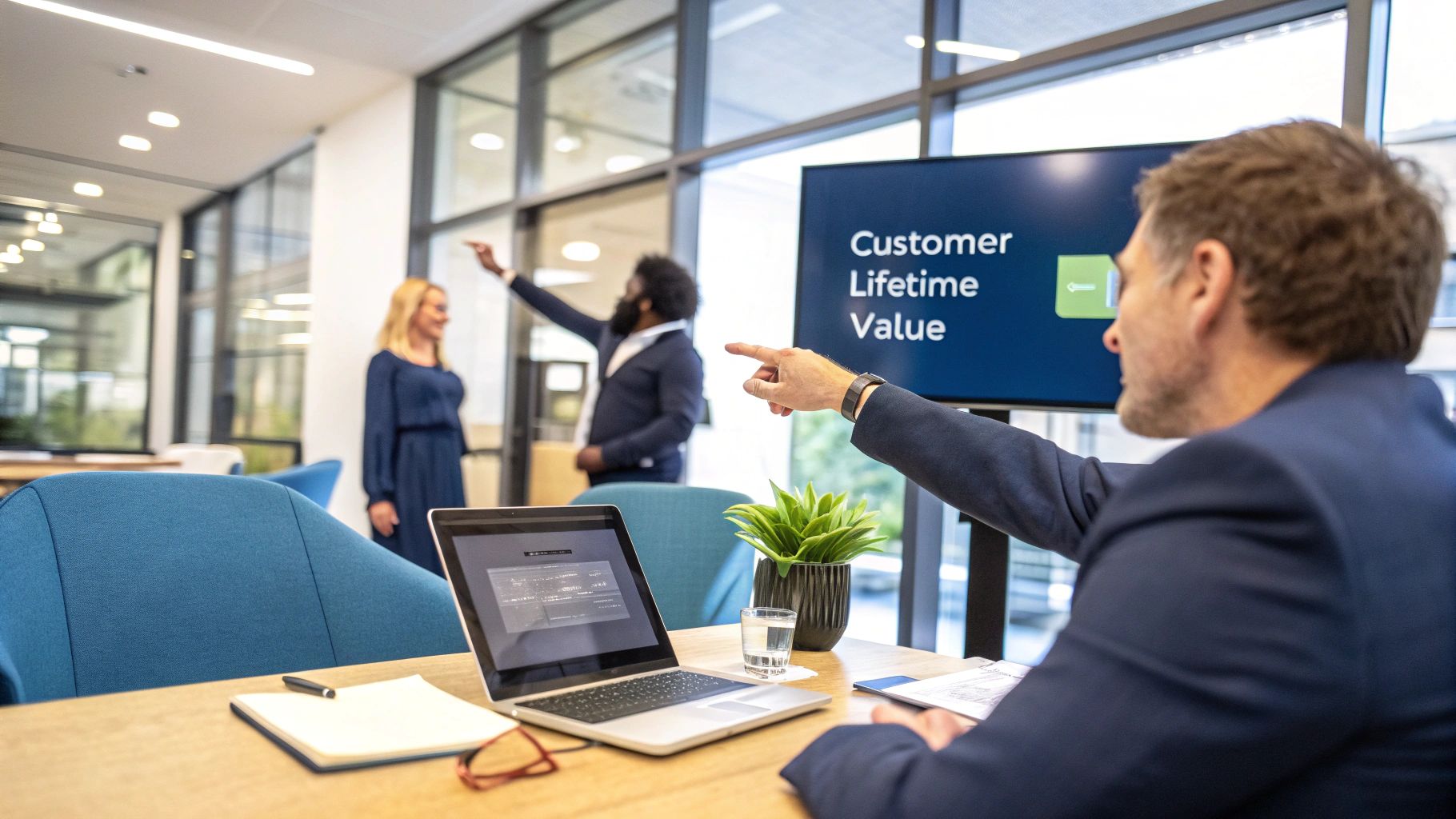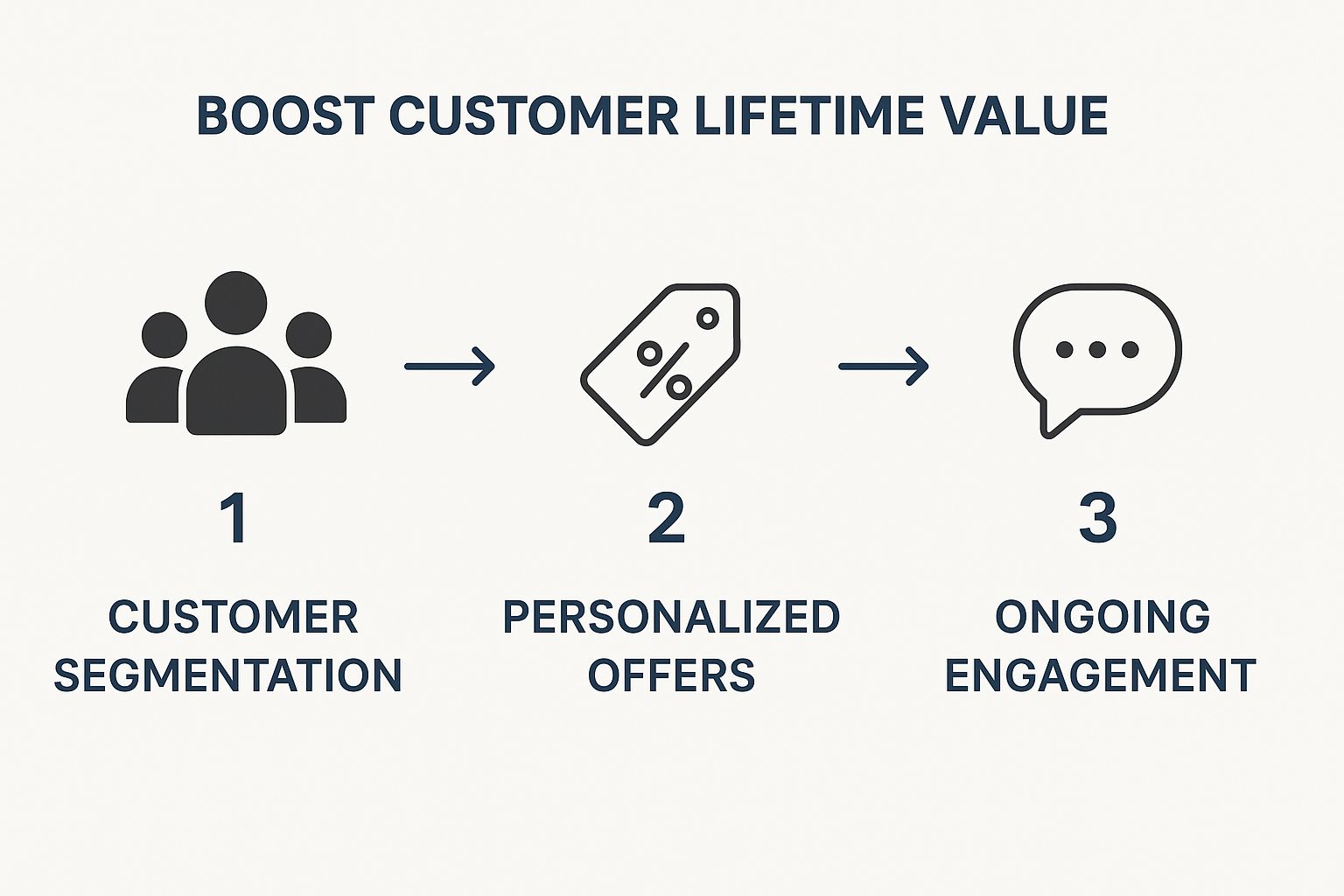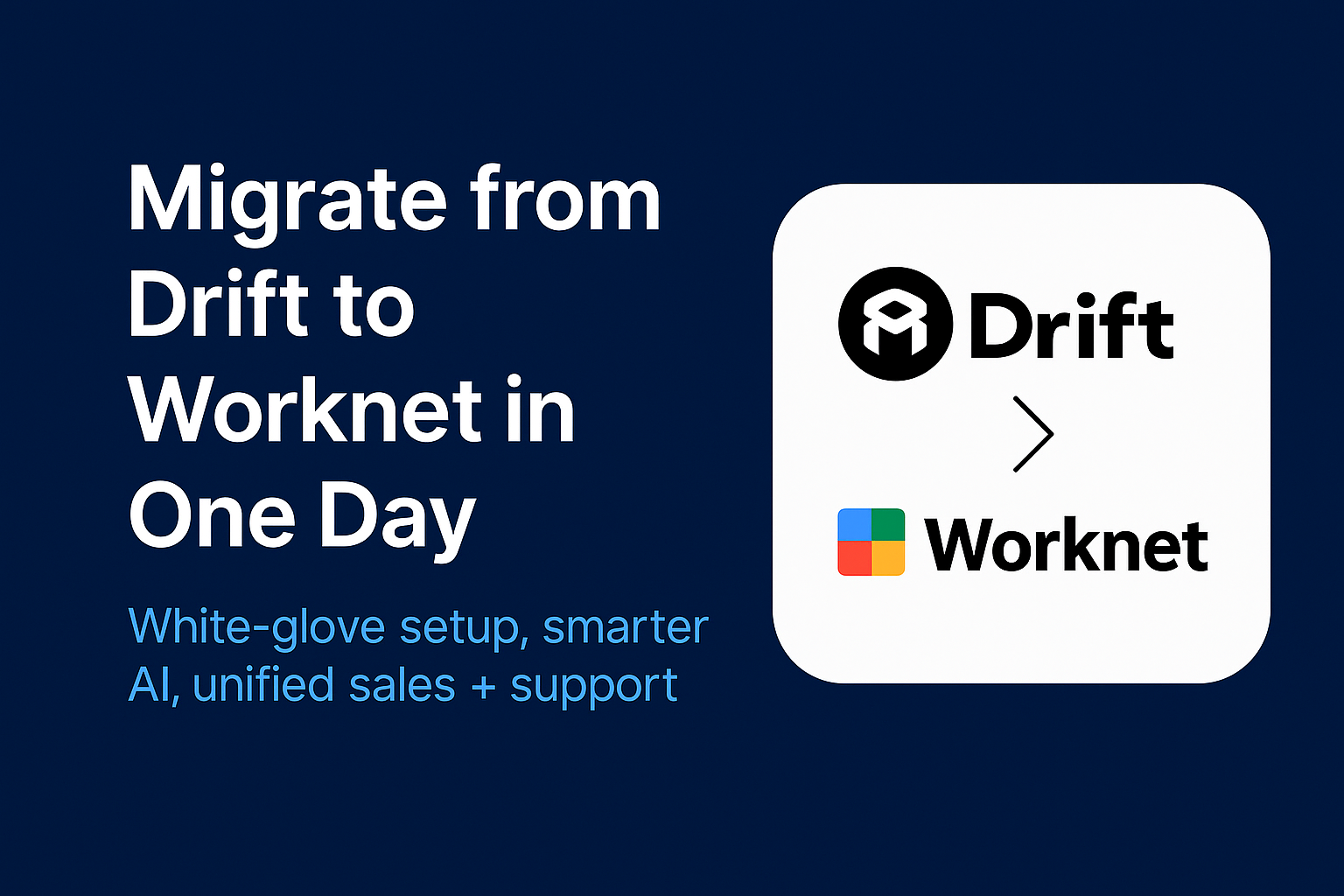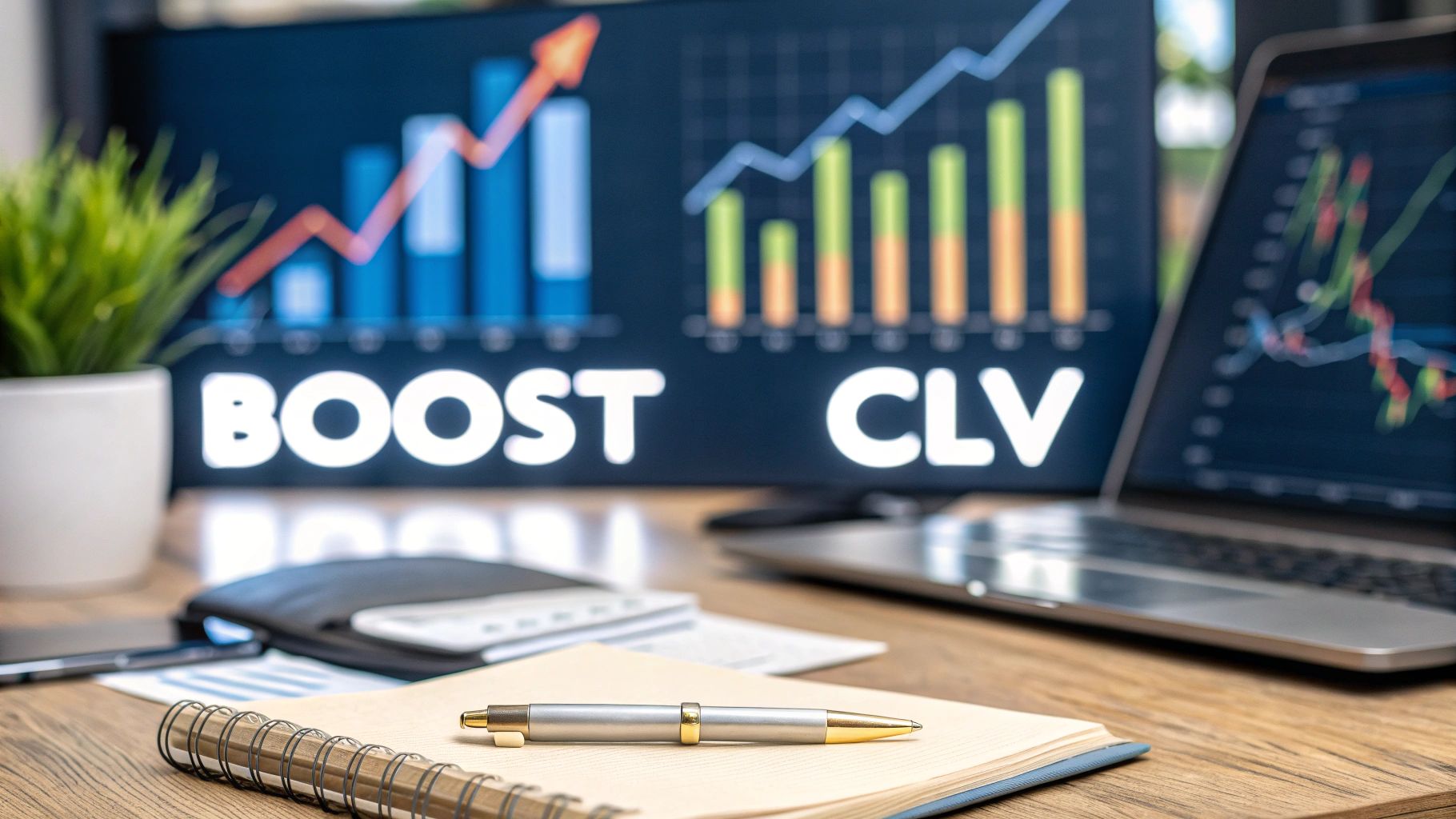14 Proven Strategies to Increase Customer Lifetime Value (CLV)
To truly grow your business, you need to see customer lifetime value for what it is: the core of sustainable growth. It's a mindset shift. Instead of pouring all your resources into acquiring more customers, you focus on getting more value from the ones you already have. You do this by creating fantastic experiences that build genuine loyalty and keep them coming back. This guide will show you exactly how to increase customer lifetime value with actionable strategies.
Why CLV Is Your Most Important Growth Metric
For the longest time, business growth was a one-track-mind game: customer acquisition. The main goal was just to stuff the top of the funnel. But that old playbook is getting ridiculously expensive and frankly, it just doesn't work as well anymore. The companies thriving today know that real, lasting growth comes from within their existing customer base. This is where Customer Lifetime Value (CLV) steals the show.
CLV is the total revenue you can reasonably expect to get from a single customer over the entire time they're with you. It’s not just about the first sale or the second. It’s the big picture—a complete look at a customer's long-term worth.
This image from HubSpot really nails down the core idea of CLV and why it's so crucial for long-term health.

As the visual points out, keeping the customers you have is way more cost-effective than constantly hunting for new ones. That makes CLV a powerful lever for your profitability.
The Financial Case for a CLV-First Strategy
Making CLV a priority isn't just some fluffy, "nice-to-have" customer service philosophy; it's a rock-solid economic strategy. The logic is simple but incredibly powerful. When you have a high CLV, it’s a clear sign that your customers are happy, loyal, and willing to spend more with you over time. This builds a predictable revenue stream that's far more resilient to the ups and downs of the market.
A CLV-centric approach turns your business from a transactional machine into a relational one. You're no longer just chasing one-off sales. Instead, you're building an ecosystem where customers feel seen, understood, and motivated to stick around.
This shift pays off in some very real ways:
- Higher Profits: Loyal customers spend more, are less sensitive to price changes, and directly fatten your profit margins.
- Lower Acquisition Costs: When you're better at keeping customers, you don't have to spend as aggressively to replace them. That frees up a lot of cash.
- Authentic Word-of-Mouth: Happy, long-term customers turn into your most passionate advocates, driving organic growth that you can't buy.
The Big Gap Between Knowing and Doing
Just about everyone in business nods their head when you talk about CLV. The problem is, putting it into practice is a different story. The data shows a massive disconnect: while an overwhelming 89% of companies agree CLV is essential for brand loyalty, only 42% feel they can actually measure it well. This gap is a huge, untapped opportunity.
Making matters worse, the cost to acquire a new customer has exploded by 222% in the past eight years. This makes focusing on CLV not just a smart move, but a necessary one for survival. If you're interested in digging deeper, you can explore a full analysis on customer lifetime value statistics.
Ultimately, learning how to increase customer lifetime value is about building a system. It's about getting every department—from marketing and sales to product and support—rowing in the same direction, all focused on creating lasting relationships with your customers.
How To Calculate Your Customer Lifetime Value
Before you can even think about growing customer lifetime value, you need to know what it is. Calculating CLV isn't just a spreadsheet exercise for the finance team; it's the critical first step that anchors your entire growth strategy. Without a solid number, you're essentially just guessing.
The good news? You don't need a PhD in statistics to get started. A simple, foundational formula is all it takes to get a reliable baseline and understand what your customers are really worth over time.
The Foundational CLV Formula
At its heart, the basic CLV calculation boils down to three core metrics. Multiply them together, and you've got your starting point. It's that straightforward.
Let's walk through it with a hypothetical SaaS company, "InnovateIQ."
- Average Purchase Value (APV): What's the average a customer spends per transaction? For InnovateIQ, we'll say their blended average monthly subscription fee is $120.
- Purchase Frequency (PF): How often do they buy? Since it's a subscription model, customers make a "purchase" 12 times per year (once a month).
- Average Customer Lifespan (ACL): How long do they stick around? InnovateIQ's data shows the average customer stays subscribed for 3.5 years.
Now, let's put it all together for InnovateIQ:
$120 (APV) x 12 (PF) x 3.5 (ACL) = $5,040
This single number—$5,040—is a game-changer. It tells the team at InnovateIQ that every new customer is, on average, worth over five thousand dollars in revenue. This insight instantly informs everything from how much they can spend on marketing to what level of investment in customer support makes sense.
To get this right, you need to be clear on what each component of the formula means.
CLV Calculation Components Explained
Here’s a simple breakdown of the metrics you'll need to calculate a basic Customer Lifetime Value for your business.
Getting these three numbers is the first and most important step. It provides the foundation upon which all other CLV optimization strategies are built.
Moving Beyond the Basics with Cohort Analysis
While the basic formula gives you a great starting point, the real magic happens when you start using cohort analysis. This just means grouping customers by when they joined—for instance, all customers from January 2023—and tracking their value over time as a distinct segment.
This approach helps you spot trends that a single, blended CLV number would completely hide.

As the flow shows, segmentation is the launchpad for everything else. You can't personalize offers or drive meaningful engagement without first understanding your different customer groups.
Why is this so powerful? Imagine discovering that:
- Customers who signed up after your big Q3 product update have a 20% higher CLV than earlier cohorts.
- Users you acquired through your podcast sponsorship campaign churn faster, leading to a much lower CLV for that group.
By breaking down your CLV by cohort, you move from knowing what your CLV is to understanding why. That deeper insight is where truly effective strategies are born.
A clear grasp of CLV also sharpens your upselling and cross-selling efforts, which are massive revenue drivers for many businesses—often accounting for around 31% of total revenues. Knowing which customer segments have the highest potential value tells you exactly where to focus those efforts for the biggest impact.
Ultimately, the goal isn't just to find a number. It's to build a repeatable process for measuring and interpreting it. For a deeper look at the different formulas and methods, you can explore how to calculate customer lifetime value effectively. This is how you gain true visibility into how your decisions impact customer loyalty and, ultimately, the health of your business.
Boost Spending With Smarter Personalization

Let's be honest: generic marketing is a fast track to being ignored. If you really want to increase customer lifetime value, you have to go deeper than just dropping a {{first_name}} tag into an email. Real, effective personalization is about creating an experience so in-tune with a customer's needs that they want to engage more and, as a result, spend more.
It all comes down to using your customer data to understand not just who they are, but what they're trying to accomplish with your product. When every interaction feels like it was built just for them, you build trust. That trust translates directly into loyalty and higher spending. In fact, research shows that 53.9% of customers see personalization as a brand recommending products based on their past behavior—they're practically telling us they value this kind of relevance.
Go Beyond Basic Onboarding
A one-size-fits-all onboarding flow is a massive missed opportunity. Your customers don't all show up with the same goals, technical chops, or expectations. A dynamic onboarding process that actually reacts to what a user does in real-time can slash their time-to-value, which is critical for long-term retention and spending.
Instead of force-feeding every new user the same five "getting started" tooltips, let their actions dictate their path. For instance, if a user immediately starts building complex reports, your system should recognize that "power user" behavior. It can then smartly skip the beginner stuff and point them toward advanced filters or data integration features.
This approach accomplishes two key things:
- It cuts down on frustration. You stop boring your advanced users with basic tutorials and stop overwhelming beginners with features they aren't ready for.
- It proves your product's value, faster. By leading users directly to the tools that solve their immediate problems, you help them hit that "aha!" moment in record time.
Suddenly, onboarding isn't a static checklist; it's a responsive conversation. As users engage, the system learns and adapts, creating a positive feedback loop that builds confidence right from the start.
Personalize Feature Recommendations and Communication
Once a customer is up and running, your personalization strategy needs to evolve from initial setup to ongoing growth. This means your communication—both in-app and via email—should be rooted in actual usage patterns, not just blasted out to your entire user base.
Think about making every message count. A customer who has never touched your collaboration features doesn't need an email about a minor update to them. But a user who is constantly bumping up against the seat limit for collaboration on their current plan? That’s a perfect candidate for a targeted upgrade message.
The goal is to solve problems before the customer even has to ask. When you analyze usage data to anticipate needs, you can proactively offer solutions. Your product transforms from a simple tool into an indispensable partner.
Here are a few ways to put this into practice:
- Usage-Based Nudges: Notice a user is manually exporting data every single week? Send them a quick in-app prompt about your automated reporting feature. Frame it as a time-saver, not a sales pitch.
- Segmented Email Campaigns: Group users based on the features they use most (or least!). Send "pro-tip" emails to your power users of a specific tool, or "did you know?" style messages to those who haven't discovered a valuable feature yet.
- Contextual Upgrade Prompts: Ditch the generic "Upgrade Now" banner. Instead, trigger upgrade suggestions at the moment of need. When a user tries to access a feature locked behind a higher tier, show them a message explaining the benefit and giving them a simple path to upgrade.
Real-World Scenario: Picture a project management SaaS. The system notices a user on its "Basic" plan has just invited their tenth team member—the max allowed. Instead of just showing an error, it triggers a personalized popup: "Looks like your team is growing! Upgrade to our 'Pro' plan to add unlimited team members and unlock advanced collaboration tools." The message is timely, relevant, and tied directly to the user's goal. It makes the upgrade feel like the next logical step, not an intrusive ad. That's how you boost CLV with smart, data-driven personalization.
Building a Unified Omnichannel Experience
A choppy, disconnected customer journey is one of the fastest ways to create friction and churn. To really boost your customer lifetime value, you need to craft an experience so seamless that customers feel supported no matter how or where they interact with your brand. For any modern SaaS company, this means building a truly unified omnichannel experience.
This goes way beyond just showing up on different platforms. It's about weaving them together. Your in-app support, email campaigns, community forums, and social media presence should all feel like different threads in the same conversation. When your messaging, branding, and the quality of your support are consistent everywhere, customers feel genuinely looked after, and that has a direct impact on their loyalty.
Think about it from the user's perspective: they open a support ticket inside your app, get a follow-up email linking to a helpful knowledge base article, and later receive a targeted in-app notification about a related feature. That's a smooth, connected experience that builds a tremendous amount of trust.
Why Consistency Across Channels Matters
Consistency is really the foundation of any good omnichannel strategy. When a customer gets conflicting information or a totally different level of service from one channel to the next, it chips away at their trust. A unified approach ensures every single touchpoint reinforces your brand's promise.
This consistency has a real, measurable impact on your bottom line, too. One of the most powerful ways to increase Customer Lifetime Value (CLV) is through omnichannel engagement. Research shows that customers who engage with a brand across multiple channels have a 30% higher CLV than those who stick to just one. On top of that, these loyal customers are incredibly valuable—existing customers are known to spend 67% more than new ones.
Weaving Your Channels Together
Creating this unified view means you have to start breaking down internal silos. Your support, marketing, and product teams can’t just operate in their own little worlds. They all need shared access to customer data and a common understanding of what the customer journey actually looks like.
Here are a few practical ways to start integrating your channels:
- Centralize Your Customer Data: Use a CRM or a customer data platform (CDP) to create a single source of truth for every customer. When a support agent can see a customer's recent marketing interactions or their in-app behavior, they can provide much more relevant and genuinely helpful service.
- Align Your Messaging: Make sure the tone, language, and any offers are consistent, whether a customer is reading a blog post, talking to a chatbot, or getting a promotional email.
- Connect Your Support Touchpoints: If a customer starts a chat on your website, that conversation history needs to be visible to an agent if the customer later calls or emails. This simple step prevents that all-too-common frustration of having to repeat the same information over and over. Our guide on effective customer communication strategies dives deeper into this.
The goal is to make the channel invisible to the customer. They shouldn't have to think about whether they're "in the app" or "on the website." They should just feel like they are interacting with your company.
The Role of Technology in Unifying the Experience
Technology is what makes a seamless omnichannel strategy possible. Automation and AI, in particular, are vital for delivering consistent, personalized support at scale. As you build out this unified experience, integrating the right tools can make all the difference.
For example, intelligent AI chatbots can provide instant, 24/7 answers to common questions on your website, inside your app, and even through social media DMs. Since they can access the same knowledge base your human agents use, the answers are always consistent. And for those times when an issue needs a human touch, the chatbot can seamlessly hand off the entire conversation history to a live agent, creating a perfectly smooth transition.
By connecting these technological dots, you create a system where every interaction builds on the last. This integrated approach doesn't just solve problems—it actively builds the kind of deep-seated loyalty that is the bedrock of a high customer lifetime value.
Designing Loyalty Programs That Actually Work

Let's be honest—most loyalty programs are an afterthought. They're usually just a generic points system that customers enroll in and promptly forget. If you want to design a program that genuinely moves the needle on retention and customer lifetime value, you have to think beyond simple discounts.
The best programs, especially in the SaaS world, tie rewards directly into what your users find valuable inside your product.
The real aim isn't just to reward a purchase; it's to reward deep engagement and true loyalty. A well-designed program makes customers feel like insiders, like valued partners in your company’s growth. It builds a community and makes it that much harder for them to even think about switching to a competitor. And the data backs this up—one report found that 80% of companies with a loyalty program saw a positive ROI.
Moving Beyond Points and Discounts
Points and discounts have a place, but they can be a double-edged sword. They often train customers to just wait for the next sale instead of building any real attachment to your product. In the world of software, value is all about utility, access, and efficiency. Your loyalty program needs to reflect that.
The models that truly click with software users are the ones that are woven directly into the product experience itself. These rewards feel earned and exclusive, offering something that a competitor can’t just undercut with a 15% off coupon. The secret is connecting loyalty directly to deeper product adoption.
Structuring a Modern SaaS Loyalty Program
I've found that a tiered system is one of the most powerful ways to structure a SaaS loyalty program. It gives customers a clear path forward, motivating them to dig deeper into the product to unlock better benefits. As they become more invested, their status grows, and so do the perks.
Here are a few innovative reward ideas that go way beyond a simple discount:
- Exclusive Feature Access: Give your most loyal customers a sneak peek at new features before anyone else. This makes them feel like VIPs and gives you priceless feedback from your most dedicated users.
- Beta Program Invitations: When you’re gearing up for a major product overhaul, invite your top-tier loyalty members into the closed beta. This is a fantastic, no-cost reward that provides huge value to users who love being on the leading edge.
- Dedicated Support Experts: Offer a real service upgrade, like access to a senior support specialist or even a dedicated account manager. For a business that depends on your software, that kind of support is worth far more than a 10% discount.
- Priority Access to Events: Let your loyal customers get first dibs on tickets for your annual conference, exclusive webinars with your product VPs, or local user group meetups.
This approach flips the script. Your program transforms from a simple marketing ploy into a core part of your customer success and product strategy. The focus shifts from "How do we get them to spend more?" to "How can we help them get more value from our product?" To dive deeper into building this kind of long-term relationship, check out our guide on how to boost your customer retention.
Real-World Scenario: Imagine an analytics SaaS company. They could build a three-tier loyalty program. Tier 1 users get early registration for webinars. Tier 2 users unlock an advanced reporting template that isn't available on their current plan. Tier 3 users—the super fans—get a one-on-one "power user" coaching session with a product expert each quarter.
This model directly encourages the very actions that lead to a higher LTV: deeper product usage, better user skill, and a stronger bond with your company.
Aligning Rewards with User Value
The secret sauce to a killer loyalty program is knowing what your users actually want. What problems are they trying to solve with your tool day in and day out?
For a marketing automation platform, users might go nuts for pre-built campaign templates. For a design tool, a library of exclusive assets would be incredibly useful.
To figure this out, you just have to listen.
- Survey Your Power Users: Straight up ask your most active customers what kind of non-monetary rewards would be most helpful for them.
- Analyze Support Tickets: Look for patterns. Are people always asking for a certain feature? Could you offer a piece of that functionality as a loyalty reward?
- Monitor Community Forums: Pay attention to what your biggest advocates are excited about. Build rewards around the features and workflows they already love.
When you design a loyalty program that offers tangible, product-related benefits, you kickstart a powerful cycle. Customers engage more to earn rewards, that engagement makes your product stickier and more valuable to them, and their loyalty becomes rock-solid—dramatically increasing their lifetime value.
Answering Your Burning CLV Questions
Even after mapping out a solid plan, jumping into customer lifetime value can feel a little daunting. Let's be honest, it’s a big shift. You're moving away from a pure acquisition game and toward building real, long-term relationships. It's natural to have questions.
So, let's tackle some of the most common ones that pop up when teams start focusing on CLV. Getting these cleared up will help you move forward with confidence.
What Is a Good Customer Lifetime Value?
This is the million-dollar question, and the real answer is... it depends. There’s simply no universal "good" CLV. A healthy number for an enterprise SaaS platform will look completely different from a B2C subscription box.
Instead of chasing a magic number, focus on a much more revealing metric: your CLV to Customer Acquisition Cost (CAC) ratio. This tells you exactly how much return you're getting on your acquisition spending. It’s the true measure of a sustainable business.
As a rule of thumb, a 3:1 ratio is a great target. For every dollar you spend to bring in a customer, you're getting three dollars back over their lifetime.
- If you're near 1:1: This is a red flag. You're basically treading water, spending a dollar to make a dollar. Growth is nearly impossible here, and it suggests you're either overspending on marketing or your customers aren't sticking around.
- If you're at 4:1 or higher: Nicely done. This points to a fantastic business model with strong customer loyalty and super-efficient acquisition efforts.
The real win isn't hitting some arbitrary industry benchmark. It's about seeing your own CLV grow month over month, quarter over quarter. If that number is trending up, you know you're doing something right.
How Do You Increase CLV in B2B?
In the B2B world, boosting CLV is all about becoming an indispensable partner, not just another vendor. You want to weave your solution so deeply into your client's operations that they can't imagine working without you.
Here are a few strategies I’ve seen work time and time again:
- Tailor Your Service: Ditch the one-size-fits-all approach. Think custom integrations, bespoke reports, or even assigning a dedicated customer success manager who truly gets their industry. The more you solve their unique problems, the stickier you become.
- Price for Growth: Your pricing should create a clear upgrade path that feels like a win for the client. As they add more users, need more data, or want advanced features, moving to a higher tier should be a no-brainer.
- Build Real Strategic Relationships: This is everything in B2B. Loyalty is earned through trust and consistent performance. Hold regular business reviews, offer proactive advice, and act as a true consultant.
Ultimately, you need to show them that your success is tied directly to theirs. When they see you as a growth partner, their lifetime value will follow.
Where Should I Start First?
It's easy to get analysis paralysis with CLV. So where do you begin? The answer is simpler than you think: Start with your customer support and feedback channels. Before you can optimize anything, you have to nail the fundamentals of the customer experience.
Great support is the bedrock of retention. When customers feel understood and their issues are resolved quickly, they stick around. In fact, a staggering 82.5% of customers are more likely to buy again from a company they feel truly gets them.
This creates a powerful positive cycle. Happy customers give better, more constructive feedback. That feedback gives you the exact blueprint you need to improve your product. The single most impactful first step you can take is to find ways to improve customer satisfaction.
Once that foundation is solid, your next move is to calculate your baseline CLV. You can't improve what you don't measure. Use the simple formula (Average Purchase Value x Purchase Frequency x Customer Lifespan) to get your starting point. This initial number becomes the benchmark you’ll work to improve.
Ready to transform your customer journey and boost lifetime value? Worknet.ai Inc combines AI-powered conversations with seamless expert handoffs to help you convert more visitors, turn trials into paying customers, and grow loyalty through a unified chat experience. See how Worknet.ai can help you build lasting customer relationships.
FAQs
.png)
Lorem ipsum dolor sit amet, consectetur adipiscing elit. Suspendisse varius enim in eros elementum tristique. Duis cursus, mi quis viverra ornare, eros dolor interdum nulla, ut commodo diam libero vitae erat. Aenean faucibus nibh et justo cursus id rutrum lorem imperdiet. Nunc ut sem vitae risus tristique posuere.
Lorem ipsum dolor sit amet, consectetur adipiscing elit. Suspendisse varius enim in eros elementum tristique. Duis cursus, mi quis viverra ornare, eros dolor interdum nulla, ut commodo diam libero vitae erat. Aenean faucibus nibh et justo cursus id rutrum lorem imperdiet. Nunc ut sem vitae risus tristique posuere.
Lorem ipsum dolor sit amet, consectetur adipiscing elit. Suspendisse varius enim in eros elementum tristique. Duis cursus, mi quis viverra ornare, eros dolor interdum nulla, ut commodo diam libero vitae erat. Aenean faucibus nibh et justo cursus id rutrum lorem imperdiet. Nunc ut sem vitae risus tristique posuere.
Lorem ipsum dolor sit amet, consectetur adipiscing elit. Suspendisse varius enim in eros elementum tristique. Duis cursus, mi quis viverra ornare, eros dolor interdum nulla, ut commodo diam libero vitae erat. Aenean faucibus nibh et justo cursus id rutrum lorem imperdiet. Nunc ut sem vitae risus tristique posuere.
Lorem ipsum dolor sit amet, consectetur adipiscing elit. Suspendisse varius enim in eros elementum tristique. Duis cursus, mi quis viverra ornare, eros dolor interdum nulla, ut commodo diam libero vitae erat. Aenean faucibus nibh et justo cursus id rutrum lorem imperdiet. Nunc ut sem vitae risus tristique posuere.
Lorem ipsum dolor sit amet, consectetur adipiscing elit. Suspendisse varius enim in eros elementum tristique. Duis cursus, mi quis viverra ornare, eros dolor interdum nulla, ut commodo diam libero vitae erat. Aenean faucibus nibh et justo cursus id rutrum lorem imperdiet. Nunc ut sem vitae risus tristique posuere.
Lorem ipsum dolor sit amet, consectetur adipiscing elit. Suspendisse varius enim in eros elementum tristique. Duis cursus, mi quis viverra ornare, eros dolor interdum nulla, ut commodo diam libero vitae erat. Aenean faucibus nibh et justo cursus id rutrum lorem imperdiet. Nunc ut sem vitae risus tristique posuere.
Lorem ipsum dolor sit amet, consectetur adipiscing elit. Suspendisse varius enim in eros elementum tristique. Duis cursus, mi quis viverra ornare, eros dolor interdum nulla, ut commodo diam libero vitae erat. Aenean faucibus nibh et justo cursus id rutrum lorem imperdiet. Nunc ut sem vitae risus tristique posuere.
Lorem ipsum dolor sit amet, consectetur adipiscing elit. Suspendisse varius enim in eros elementum tristique. Duis cursus, mi quis viverra ornare, eros dolor interdum nulla, ut commodo diam libero vitae erat. Aenean faucibus nibh et justo cursus id rutrum lorem imperdiet. Nunc ut sem vitae risus tristique posuere.
Lorem ipsum dolor sit amet, consectetur adipiscing elit. Suspendisse varius enim in eros elementum tristique. Duis cursus, mi quis viverra ornare, eros dolor interdum nulla, ut commodo diam libero vitae erat. Aenean faucibus nibh et justo cursus id rutrum lorem imperdiet. Nunc ut sem vitae risus tristique posuere.


.svg)


.webp)
.webp)
.webp)




